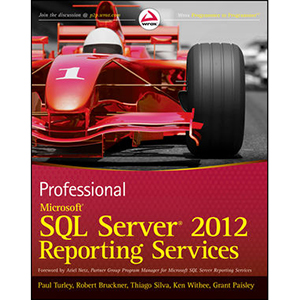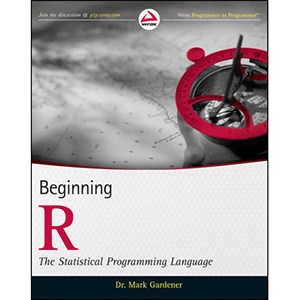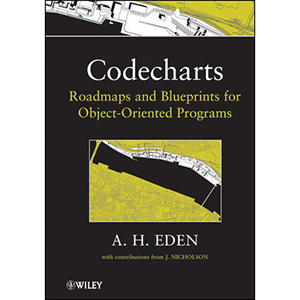Wow! eBook: Professional Augmented Reality Browsers for Smartphones - 6 new eBooks |  |
- Professional Augmented Reality Browsers for Smartphones
- Professional Microsoft SQL Server 2012 Reporting Services
- Beginning R
- Codecharts
- Building Software for Simulation
- Beyond Redundancy
| Professional Augmented Reality Browsers for Smartphones Posted: 13 Jun 2012 10:42 AM PDT
Book DescriptionCreate amazing mobile augmented reality apps with junaio, Layar, and Wikitude! Professional Augmented Reality Browsers for Smartphones guides you through creating your own augmented reality apps for the iPhone, Android, Symbian, and bada platforms, featuring fully workable and downloadable source code. You will learn important techniques through hands-on applications, and you will build on those skills as the book progresses. Professional Augmented Reality Browsers for Smartphones:
Table of Contents Part II: Wikitude Part III: Layar Part IV: Junaio Part V: The Next Steps Appendix A. Wikitude Support and ARML Parameters Book Details
Related Posts
|
| Professional Microsoft SQL Server 2012 Reporting Services Posted: 13 Jun 2012 05:43 AM PDT
Book DescriptionA must-have guide for the latest updates to the new release of Reporting Services QL Server Reporting Services allows you to create reports and business intelligence (BI) solutions. With this updated resource, a team of experts shows you how Reporting Services makes reporting faster, easier and more powerful than ever in web, desktop, and portal solutions. New coverage discusses the new reporting tool called Crescent, BI semantic model’s impact on report design and creation, semantic model design, and more. You’ll explore the major enhancements to Report Builder and benefit from best practices shared by the authors.
Professional Microsoft SQL Server 2012 Reporting Services is mandatory reading if you are eager to start using the newest version of SQL Server Reporting Services. From the Back Cover Whether you’re creating an invoice for a small business or a BI dashboard to help manage a multinational corporation, you need to deliver accurate information. This book shows you how to accomplish this by walking you through Microsoft’s reporting platform. You’ll dive into SQL Server 2012 Reporting Services’ architecture and BI fundamentals, as well as the key ingredients to successful report design. You’ll then get up to speed on building business reports with Report Builder and using Power View to make fast, interactive, visual analytics pervasive and accessible to business users. Professional Microsoft SQL Server 2012 Reporting Services:
Table of Contents Part II: Report Design Part III: Business Intelligence Reporting Part IV: Enabling User Reporting Part V: Solution Patterns Part VI: Administering Reporting Services Part VII: Reporting Services Custom Programming Part VIII: Appendixes Book Details
Related Posts
|
| Posted: 13 Jun 2012 05:33 AM PDT
Book DescriptionConquer the complexities of this open source statistical language R is fast becoming the de facto standard for statistical computing and analysis in science, business, engineering, and related fields. This book examines this complex language using simple statistical examples, showing how R operates in a user-friendly context. Both students and workers in fields that require extensive statistical analysis will find this book helpful as they learn to use R for simple summary statistics, hypothesis testing, creating graphs, regression, and much more. It covers formula notation, complex statistics, manipulating data and extracting components, and rudimentary programming.
Beginning R offers anyone who needs to perform statistical analysis the information necessary to use R with confidence. From the Back Cover While R is very flexible and powerful, it is unlike most of the computer programs you have used. In order to unlock its full potential, this book delves into the language, making it accessible so you can tackle even the most complex of data analysis tasks. Simple data examples are integrated throughout so you can explore the capabilities and versatility of R. Along the way, you’ll also learn how to carry out a range of commonly used statistical methods, including Analysis of Variance and Linear Regression. By the end, you’ll be able to effectively and efficiently analyze your data and present the results. Beginning R:
Table of Contents Book Details
Related Posts
|
| Posted: 13 Jun 2012 05:25 AM PDT
Book DescriptionNEW LANGUAGE VISUALIZES PROGRAM ABSTRACTIONS CLEARLY AND PRECISELY Popular software modelling notations visualize implementation minutiae but fail to scale, to capture design abstractions, and to deliver effective tool support. Tailored to overcome these limitations, Codecharts can elegantly model roadmaps and blueprints for Java, C++, and C# programs of any size clearly, precisely, and at any level of abstraction. More practically, significant productivity gains for programmers using tools supporting Codecharts have been demonstrated in controlled experiments. Hundreds of figures and examples in this book illustrate how Codecharts are used to:
Tools supporting Codecharts are also shown here to:
This classroom-tested book includes two main parts: Practice (Part I) offers experienced programmers, software designers and software engineering students practical tools for representing and communicating object-oriented design. It demonstrates how to model programs, patterns, libraries, and frameworks using examples from JDK, Java 3D, JUnit, JDOM, Enterprise JavaBeans, and the Composite, Iterator, Factory Method, Abstract Factory, and Proxy design patterns. Theory (Part II) offers a mathematical foundation for Codecharts to graduate students and researchers studying software design, modelling, specification, and verification. It defines a formal semantics and a satisfies relation for design verification, and uses them to reason about the relations between patterns and programs (e.g., “java.awt implements Composite” and “Factory Method is an abstraction of Iterator”). Book Details
Related Posts
|
| Building Software for Simulation Posted: 13 Jun 2012 05:21 AM PDT
Book DescriptionA unique guide to the design and implementation of simulation software This book offers a concise introduction to the art of building simulation software, collecting the most important concepts and algorithms in one place. Written for both individuals new to the field of modeling and simulation as well as experienced practitioners, this guide explains the design and implementation of simulation software used in the engineering of large systems while presenting the relevant mathematical elements, concept discussions, and code development. The book approaches the topic from the perspective of Zeigler’s theory of modeling and simulation, introducing the theory’s fundamental concepts and showing how to apply them to engineering problems. Readers will learn five necessary skills for building simulations of complicated systems:
The central chapters of the book introduce, explain, and demonstrate the elements of the theory that are most important for building simulation tools. They are bracketed by applications to robotics, control and communications, and electric power systems; these comprehensive examples clearly illustrate how the concepts and algorithms are put to use. Readers will explore the design of object-oriented simulation programs, simulation using multi-core processors, and the integration of simulators into larger software systems. The focus on software makes this book particularly useful for computer science and computer engineering courses in simulation that focus on building simulators. It is indispensable reading for undergraduate and graduate students studying modeling and simulation, as well as for practicing scientists and engineers involved in the development of simulation tools. Book Details
Related Posts
|
| Posted: 13 Jun 2012 05:18 AM PDT
Book DescriptionHow Geographic Redundancy Can Improve Service Availability and Reliability of Computer-Based Systems Enterprises make significant investments in geographically redundant systems to mitigate the very unlikely risk of a natural or man-made disaster rendering their primary site inaccessible or destroying it completely. While geographic redundancy has obvious benefits for disaster recovery, it is far less obvious what benefit georedundancy offers for more common hardware, software, and human failures. Beyond Redundancy provides both a theoretical and practical treatment of the feasible and likely benefits from geographic redundancy for both service availability and service reliability. The book is organized into three sections:
A complete georedundant case study is included to illustrate the recommendations. The book considers both georedundant systems and georedundant solutions. The text also provides a general discussion about the capital expense/operating expense tradeoff that frames system redundancy and georedundancy. These added features make Beyond Redundancy an invaluable resource for network/system planners, IS/IT personnel, system architects, system engineers, developers, testers, and disaster recovery/business continuity consultants and planners. Book Details
Related Posts
|
| You are subscribed to email updates from Wow! eBook - Blog To stop receiving these emails, you may unsubscribe now. | Email delivery powered by Google |
| Google Inc., 20 West Kinzie, Chicago IL USA 60610 | |







Tidak ada komentar:
Posting Komentar